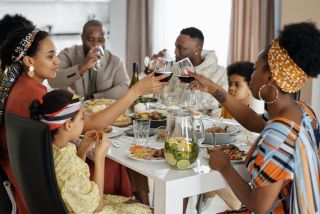Relationships
Dinner Chat With Hearing Loss Comes With a Side of Disaster
A Personal Perspective: How to communicate with people with hearing loss.
Posted June 7, 2023 Reviewed by Lybi Ma

Someone at the end of the table was telling a funny story. Someone else jumped in to add a related comment or share an anecdote. Interrupting was the norm. As was covering mouths with hands when speaking. The pace was rapid-fire. The background noise was incessant. But nobody seemed to mind. There were smiles and laughter and joy — a celebration of the camaraderie and interconnection of the group as each person enjoyed this special connection with new friends.
Except for me. I was at the other end of the table, too far from the speaker to get in on the action and too overwhelmed with the pace of the overlapping chatter to even try. I felt isolated and alone. This dinner came with a side of disaster.
How to Speak to Someone With Hearing Loss
Communicating with someone with hearing loss takes some work, especially in a group situation like a meal but there are ways to improve it.
1. Keep your mouth visible: People with hearing loss hear with their ears and their eyes. Seeing your lips provides critical lipreading cues that help us with speech comprehension.
2. Speak one person at a time: An orderly flow of conversation is essential for lipreading. If more than one person is speaking, we don't know where to look. Overlapping voices are also very challenging to disentangle.
3. Speak clearly and at a moderate pace: Rapid speech leaves too little processing time as we work to piece together the auditory and visual information we are receiving into a coherent sentence. Enunciate your words as clearly as you can. Perhaps a renewed emphasis on diction would benefit us all.
4. Face us even when talking to others: This is a hard one because, naturally, people turn towards their conversation partners, but if that happens to be in the opposite direction to where we are seated, we probably won't be able to hear.
5. Optimize the seating arrangement. I try to organize the table so that the most challenging speaker for me to hear is seated across from me on the diagonal. That way when that person turns to speak to the person next to them, it is still likely to be in my general direction. This works best in a group of four.
6. Be prepared to repeat or rephrase. It often saves time and frustration if I repeat the words that I have heard so my conversation partner only has to fill in the part that I missed.
7. Be attentive. Glance over at the person with hearing loss occasionally to see if they are following the conversation. If they are leaning forward or looking confused, they probably are having trouble. Adjusting your behavior before being asked is tremendously thoughtful.
8. Don't shout. Louder is not always better for people with hearing loss. Clarity can often be more helpful than additional volume. Yelling also distorts your lips making lipreading harder.
Communication best practices like these take a bit of extra effort to implement at first, but with repeated use, they become second nature, helping those in your life who have hearing loss stay connected and engaged.
Copyright: Living With Hearing Loss/Shari Eberts. Reprinted with permission


